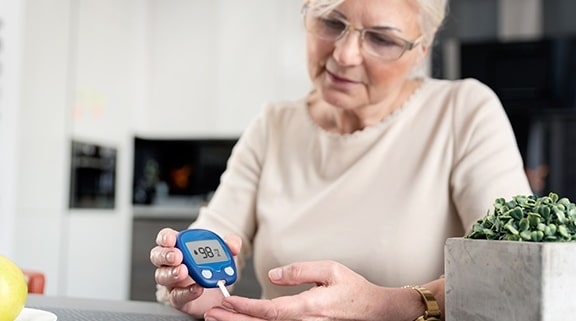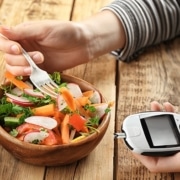How Frequently Should You Test Blood Glucose Levels? | ADS
If you’ve recently been diagnosed with diabetes, it’s essential to start building your diabetes management strategy right away. Along with a diabetes diet and regular exercise, blood glucose tests are a crucial element of any attempt to keep diabetes symptoms under control.
Still, there are some things you’ll need to know before your first blood sugar test. Here, you’ll learn when you should check your blood sugar and much more about blood glucose testing.

The Importance of Blood Sugar Tests
When you’re trying to manage diabetes, every decision matters – countless factors can play a role in your ability to live with this disease. These include everything from what you eat, to how much physical activity you get, to whether or not you smoke. Because so many things can have positive or negative effects on your diabetes management, having some way to keep track of everything is crucial.
Blood sugar numbers are the most effective way to see how lifestyle changes have impacted your diabetes. By testing your blood sugar levels, you can get regular updates on the effectiveness of your approach to diabetes management. You’ll also be able to make changes if something isn’t working, lowering your likelihood of running into serious complications later on.
Blood Sugar Testing 101
There are two blood sugar testing methods you need to know about:
- Blood sugar self-tests, and
- The Hemoglobin A1C test.
For now, we’ll focus on the first method. When testing your blood sugar, you’ll need to use a blood glucose meter. These devices can quickly measure the amount of sugar contained in a single drop of your blood, making them valuable tools for people with diabetes.
That said, no two blood glucose meters work identically. You’ll need to read the instructions that come with your meter to make sure you’re using it correctly – if you get confused, your healthcare team will be able to help. Some meters can also automatically store blood sugar test results; if yours doesn’t, it’s important to write down your results manually so you can share them with your healthcare team later on.
When to Test Your Blood Sugar
Generally speaking, people with diabetes can benefit from checking their blood sugar regularly. But based on things like the medications you use to control diabetes and the type of diabetes you have, your ideal testing schedule could look very different from someone else’s.
If you have type 1 diabetes, there’s a good chance that you’ll need to test your blood sugar more often than people with other types of diabetes. The same holds true for people who have type 2 diabetes but need to take insulin to manage this condition. On the other hand, people who have type 2 diabetes but don’t need insulin may be testing their blood sugar much less often. Still, it’s important to note that people in this category should still have access to a glucose meter.
Many people with diabetes find that some good times to test their glucose levels are:
- Immediately after waking up
- Right before a meal
- Two hours after the start of eating a meal
- Just before bed
To make sure your blood sugar testing schedule is as close as possible to your individual needs, make sure to work with your healthcare team when setting it up.
Don’t Be Afraid to Change Your Testing Schedule
While it’s healthy to have a schedule for testing your blood sugar levels, flexibility is essential, too. There are some situations where checking these levels more or less often than usual may be wise.
When you’re dealing with unusual circumstances, keeping an extra-close eye on your glucose levels can go a long way. Remember this when:
- You’ve come down with any sort of illness
- Your blood glucose levels are out of range more often than normal
- You plan on getting an abnormally high amount of exercise
Meanwhile, you might not need to test your blood sugar as often as you have been if you’ve successfully managed your diabetes for a long time. Your doctor will inform you if and when this is the case – don’t cut down on testing without their OK.
Know Your Target Blood Glucose Levels
No matter how diligent you are when testing your blood sugar and recording your results, it won’t help if you don’t know what you’re aiming for. To give you a head start, many people with diabetes strive for these goals:
- Before a meal: 80-130
- Two hours after eating: Under 180
These numbers are just meant to give you a sense of what common target numbers look like. Ask your healthcare team what your target readings are!
How to Respond to High or Low Readings
If your readings are significantly higher than your target level, you’re dealing with something called “hyperglycemia” – put simply, high blood sugar. If you don’t take care of this condition, it can eventually cause severe damage. Hyperglycemia can be treated by drinking a glass of water and if you feel alright, taking a walk. Also, you might have to make changes to what you ate in your meals. If exercise and changes in your diet do not work, your doctor may change the amount of your medication or insulin or possibly the timing of when you take it. However, let your healthcare team know if this happens to you three or more times within two weeks.
It’s not a good idea to keep your blood sugar as low as possible, either – that’s called “hypoglycemia,” and it poses significant dangers of its own. If your blood sugar levels are under 70, respond by consuming fast-acting carbs, like glucose tablets, fruit juice, or (non-diet) soda. Also, contact your physician of frequent daily occurrences of hypoglycemia.
What Sets the Hemoglobin A1C Test Apart?
It may be confusing for people who are good at keeping up on their daily blood sugar tests to learn that you need to get another blood glucose test multiple times each year. However, getting Hemoglobin A1C tests is a necessary part of your approach to diabetes management. What does this test measure? The CDC explains that when sugar enters your bloodstream, it attaches to hemoglobin, a protein in your red blood cells. Everyone has some sugar attached to their hemoglobin, but individuals with higher blood sugar levels have more. The A1C test measures the percentage of your red blood cells that have sugar-coated hemoglobin.
Unlike self-monitoring tests, the A1C test is designed to help you and your healthcare team keep track of your average blood glucose levels over the last 3 months. This test can also help determine the medications you need and the ideal dosage of these medications.
Additionally, the results of A1C tests are different from the results of “normal” glucose tests. Your healthcare team will find an A1C goal number that fits your situation; for many people with diabetes, the goal is a result under 7 percent. You’ll need to get an A1C test at least twice a year, with additional tests necessary if your results are above your goal or your treatment methods change.
Find Glucose Testing Supplies You Can Trust
A successful blood glucose testing plan starts with knowledge of how often you should check your blood sugar. But to do so, you’ll have to get reliable equipment and supplies.
ADS can provide everything you need to test your blood glucose levels. Choose us for blood glucose meters, testing supplies, and much more. It’s easy to get started – just visit our online shop to see what we have available!







